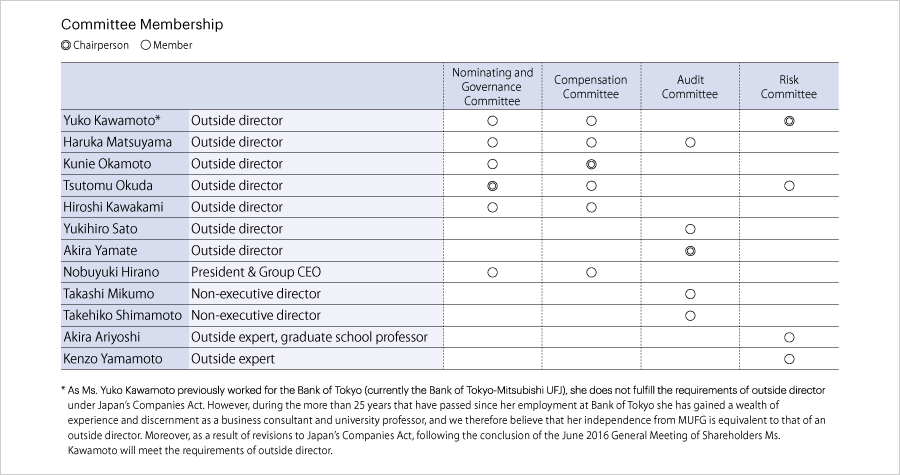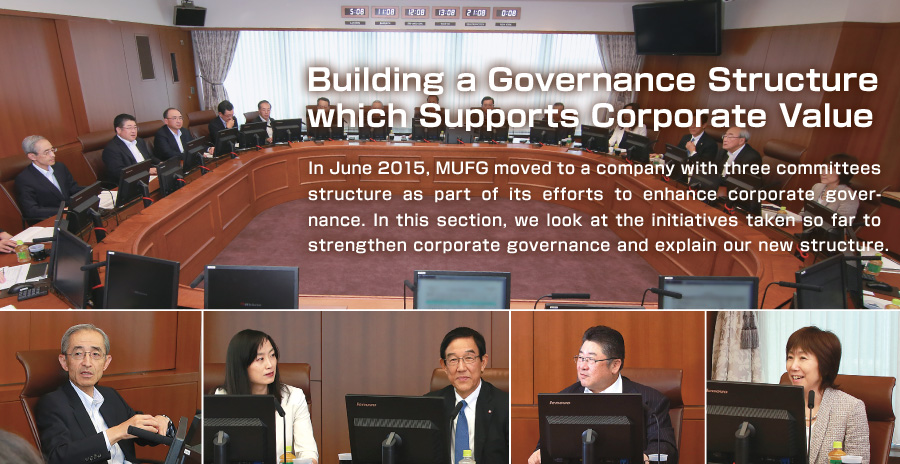Steps to Improve Corporate Governance
Since its establishment in October 2005, MUFG has worked to build a stable and effective corporate governance structure in order to ensure that external oversight of the company is working properly. We have increased the number of outside directors and formed voluntary committees (including the Nomination and Compensation Committee and Internal Audit and Compliance Committee).
Responding to various developments such as the revised Companies Act and tightened global financial regulations, we have continually debated the best forms of corporate governance at study committees with outside parties such as lawyers, and at Governance Council with our outside directors.
As a result, we have implemented several measures to enhance our corporate governance approach. In 2013, we established the Risk Committee under the Board of Directors. In 2014, we both increased the number of outside directors (note) from three to five, and formed the Governance Committee under the Board of Directors. Those five outside directors reflect a wide range of experience from corporate management in the manufacturing, retail and finance fields to a university professor and lawyer. We have also introduced a framework to regularly evaluate the Board of Directors’ working practices.
(note)Outside directors include non-executive directors with a high degree of independence from MUFG. The same applies to all references on pages 50-57.
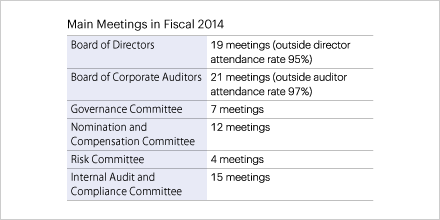
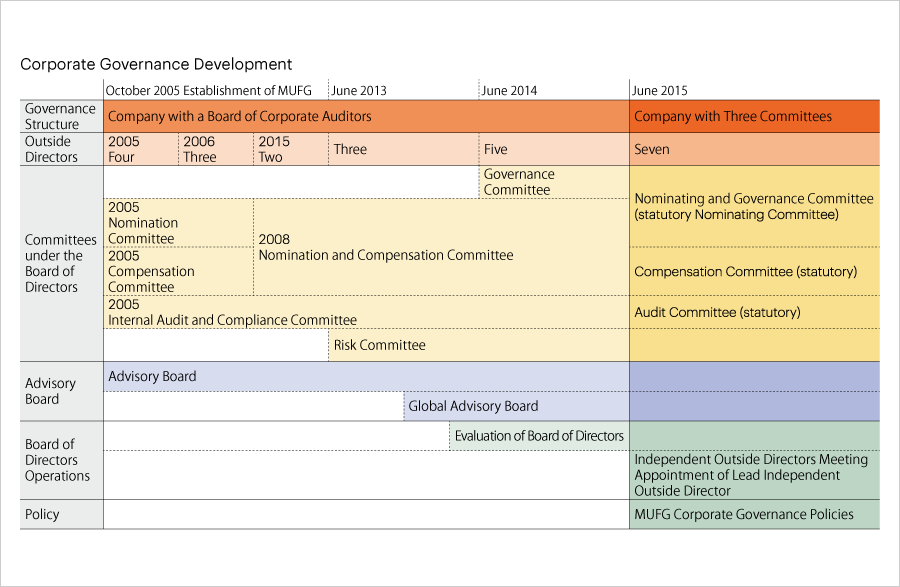
Outline of MUFG Corporate Governance Policies
1. Purpose
Demonstrate our approach to, and framework for, MUFG’s corporate governance and serve as a guide for the actions of directors and management.
2. Approach to corporate governance
Aim for sustained growth and increase in corporate value over the medium- to long-term, in consideration of the perspectives of its stakeholders, including shareholders, customers, employees, and local communities.
3. Role of the Board of Directors
The Board of Directors is responsible for oversight of management. Decisions on matters of business execution other than specific matters stipulated by law shall, in principle, be delegated to Corporate Executive Officers.
4. Duties of Directors
Directors, as appointed by the shareholders and entrusted as managers, owe a duty of loyalty and a duty of care.
5. Composition and other matters regarding the Board of Directors
The Board of Directors shall have a balanced composition providing a wealth of knowledge and expertise, with at least one-third of the board members being independent outside directors, and a majority being non-executive directors, including independent outside directors.
To ensure the effectiveness of oversight of Group management, the Presidents and CEOs of Bank of Tokyo-Mitsubishi UFJ, Mitsubishi UFJ Trust and Banking and Mitsubishi UFJ Securities Holdings will, in principle, also serve as directors of MUFG.
6. Operation of the Board of Directors
The role of Chairman of the Board of Directors and the role of President & CEO shall be separated, and a suitable director shall be appointed as Chairman to ensure that the Board of Directors effectively fulfills its role of management oversight.
Independent outside directors may appoint a Lead Independent Outside Director from among themselves.
7. Committees
In addition to the establishment of the statutory Nominating and Governance Committee, Compensation Committee and Audit Committee, a Risk Committee shall also be established.
The Nominating and Governance Committee will deliberate on matters pertaining to corporate governance as well as the appointment and removal of directors.
The Audit Committee shall have one or more full-time committee member.
8. Corporate Executive Officers
Corporate Executive Officers shall execute business and make decisions on the execution of business delegated by the Board of Directors.
9. Relations with shareholders and other stakeholders
MUFG will act appropriately to ensure shareholder rights and their appropriate exercise.
10. Appropriate disclosure of information
MUFG will ensure transparency through appropriate disclosure of information, with the aim to ensure that stakeholders evaluate MUFG based on a proper understanding.
Move to a Company with Three Committees Structure
MUFG moved to a company with three committees structure in June 2015 as part of our efforts to further enhance corporate governance from a medium-longterm perspective. With the aim of enhancing group management, the functions of oversight and execution in the holding company are separated, thereby strengthening the oversight function of the Board of Directors. The committee system has also been reorganized for more effective governance. We are aiming for a governance framework that will be more familiar and transparent to overseas stakeholders, in line with our status as a G-SIFI (Global Systemically Important Financial Institution).
To set out the policy and framework of the corporate governance of MUFG and to serve as a guide for the actions of directors and management, MUFG Corporate Governance Policies has been formulated.
Establishment of C-Suite
C-Suite is the general term for the Chief Financial Officer (CFO), Chief Risk Officer (CRO) and other positions. MUFG positions the holding company C-Suite as the C-Suite for the entire Group, coordinating the functions of planning and management divisions. By managing each function across the Group, the C-Suite aims to strengthen its support for Group-wide business strategy, and enhance governance structures to a level appropriate to a G-SIFI.
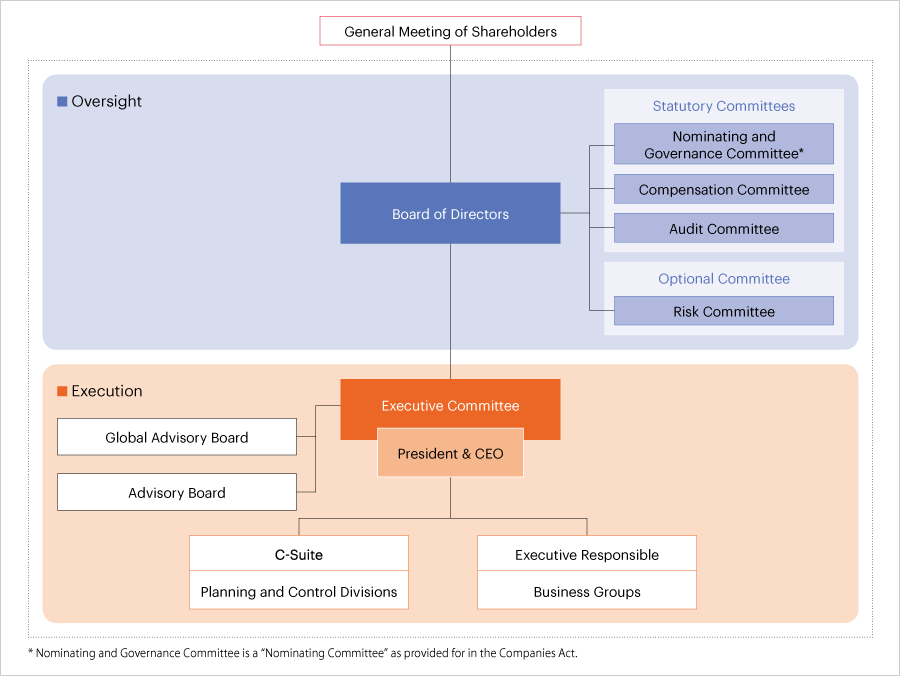
Outline of Board of Directors and Committees
The Board of Directors is responsible for the oversight and direction of the Group. It is composed of 17 members, of whom 7 (over one third) are either outside directors or non-executive directors with a high degree of independence. Of the 17 directors, the majority (9) are non-executive directors.
The outside directors are a balanced group (corporate management, a university professor, a lawyer and an accountant) with a diverse range of experience and expertise.
Nominating and Governance Committee
The Committee is composed of outside directors and the President & CEO, with an outside director as Chairperson. The Committee decides on proposals for appointment or dismissal of directors which will be submitted to the General Meetings of Shareholders. It also discusses matters related to the Chairman, Vice-Chairman,President, and other major management positions in the holding company or major subsidiaries and makes recommendations to the Board of Directors. It examines corporate governance policy and framework and makes recommendations to the Board of Directors.
Audit Committee
The Committee is composed of outside directors and non-executive directors, with an outside director as Chairperson. The Committee examines the execution of business by directors and corporate executive officers and prepares auditing reports. It also examines the business and financial situation of the holding company and subsidiaries, conducting fieldwork where necessary.
Compensation Committee
The Committee is composed of outside directors and the President & CEO, with an outside director as Chairperson. The Committee decides the compensation policy for directors and corporate executive officers and also decides the details of individual compensation. It examines the compensation systems for senior management at the holding company and major subsidiaries and makes recommendations on establishment and reform to the Board of Directors.
Risk Committee
The Committee is composed of outside directors and outside experts, with an outside director as Chairperson. The Committee examines matters related to Group-wide risk management and reports to the Board of Directors. It examines major issues related to risk management and compliance, as well as other issues that need to be examined by the Risk Committee and makes recommendations to the Board of Directors.
